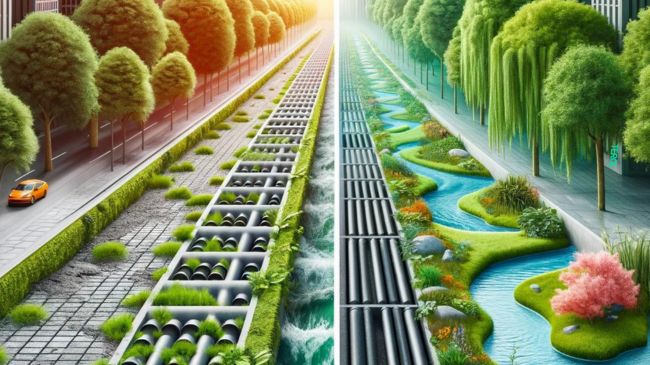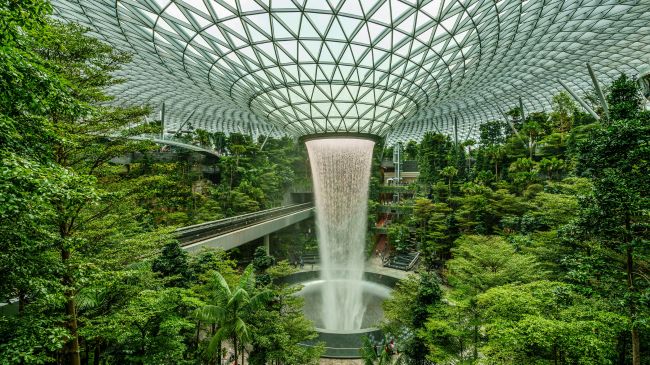Designing Sustainable Urban Drainage Systems (SuDS) for resilient cities – In an era where cityscapes are often likened to concrete jungles, there’s a silent, unsung hero working tirelessly beneath our feet—urban drainage systems. But, as modern-day environmental crusaders, we’re not just talking about any old network of pipes and gutters. Oh no, we’re diving into the world of Sustainable Urban Drainage Systems, affectionately known as SuDS. These aren’t your grandmother’s drainage solutions; they’re the future of water management in resilient cities. So, buckle up, and let’s take a playful plunge into the world of SuDS!

The splashy basics of SuDS
Imagine if every time it rained, our cities could smile, soak up the water like a sponge, and say, “Thank you, I needed that!” Well, with SuDS, that’s the dream we’re turning into reality. SuDS are a collection of water management practices that aim to mimic natural drainage processes, reducing the impact of urbanization on flooding and water quality. Instead of shooing water away as quickly as possible, SuDS whisper sweet nothings to rainwater, encouraging it to stick around, infiltrate the ground, and replenish our aquifers.
Why SuDS are the bee’s knees
In the past, urban drainage was all about getting rid of water. “Out of sight, out of mind,” they said. But this old-school approach is as outdated as flip phones. Here’s why SuDS are stealing the spotlight:
- Flood Reduction: SuDS act like a pressure valve for cities, reducing the risk of flash floods by slowing down rainwater runoff.
- Water Quality: They naturally filter pollutants, making our waterways cleaner and happier.
- Biodiversity Boost: SuDS create lush, green spaces that are a magnet for wildlife, turning concrete corners into urban oases.
- Climate Resilience: With climate change knocking on our doors, SuDS help cities adapt to more extreme weather patterns.
Designing SuDS with a splash of creativity
Designing a SuDS is like throwing a block party for water; everyone’s invited, and you need to ensure all guests mingle seamlessly. Here’s how civil engineering companies can craft SuDS that are as effective as they are enchanting:
- Porous Pavements: Let’s start with the dance floor. Porous pavements invite water to seep through, reducing runoff and recharging groundwater.
- Rain Gardens: Picture these as the chill-out zones. Rain gardens are shallow, planted depressions that absorb rainwater, providing a scenic spot for both water and wildlife.
- Green Roofs: These are the VIP lounges of urban drainage. Green roofs absorb rainfall, provide insulation, and turn buildings into bird-friendly hangouts.
- Swales: Think of swales as the winding rivers of the party, guiding rainwater across landscapes to areas where it can be absorbed or collected.
SuDS in action: Real-world ripples
Across the globe, cities are embracing it with open arms and seeing remarkable results. From London’s Queen Elizabeth Olympic Park, which showcases an innovative water management system, to Singapore’s Sponge City Initiative, which aims to absorb and reuse 70% of rainwater, SuDS are making waves. These projects are not just about managing water; they’re about reimagining urban spaces where nature and humanity thrive side by side.

Spreading the SuDS gospel
The beauty of SuDS lies in their versatility and scalability. Whether you’re retrofitting an old neighborhood or designing a new development, there’s a SuDS solution that fits. But, spreading the SuDS gospel requires a shift in mindset. It’s about seeing rainwater not as a nuisance, but as a precious resource. It’s about collaboration between engineers, urban planners, landscape architects, and the community. Together, we can turn our cities into resilient, water-wise havens.
Integrating Innovation and Efficiency: Roads and Resilience in SuDS-Enhanced Cities
Delving into the synergy of innovative road design and cost-efficiency, this section underscores their pivotal roles in enhancing Sustainable Urban Drainage Systems (SuDS) and fostering resilient, sustainable urban landscapes.
Effective Road Design: Paving the Way for SuDS Integration
Roadways play a pivotal role in urban water management, especially when aligned with SuDS principles. Effective road design that incorporates SuDS can significantly enhance urban resilience by managing runoff and reducing flood risks. Innovative approaches such as permeable pavements allow rainwater to infiltrate the ground directly, mitigating runoff and recharging groundwater supplies. Green streets, equipped with bioretention systems, not only manage stormwater but also add aesthetic value and improve air quality. By adopting these best practices in road design, cities can ensure their infrastructure works in harmony with natural water cycles, leading to more sustainable and resilient urban environments.
Cost-Efficient Projects: Maximizing SuDS Value
Implementing SuDS in urban development projects presents an opportunity to achieve sustainability goals while also being mindful of budget constraints. Cost-efficiency in SuDS projects doesn’t mean cutting corners but rather optimizing resources and leveraging natural systems to manage water. Techniques such as rain gardens, swales, and green roofs provide multipurpose benefits: they enhance biodiversity, improve water quality, and reduce flood risks, all while contributing to the aesthetic and social value of urban spaces. By prioritizing cost-effective SuDS solutions, cities can enjoy the long-term benefits of improved resilience and sustainability without excessive upfront costs. This approach ensures that investments in SuDS contribute to the overall economic and environmental health of urban areas.
Making a splash with your SuDS project
For civil engineering companies looking to dive into the SuDS pool, here’s how to make a splash:
- Educate and Engage: Start by educating your team and stakeholders about the benefits of SuDS. Engagement is key to overcoming resistance to new ideas.
- Think Holistically: SuDS are not just technical solutions; they’re part of a broader urban ecosystem. Approach projects with an interdisciplinary mindset.
- Innovate: Use your projects as a canvas to experiment with creative SuDS features. The more unique and effective your solutions, the more they’ll stand out.
- Advocate for Policy Change: Work with local governments to promote policies that support SuDS implementation. Policy can be a powerful tool in paving the way for innovative water management strategies.

Conclusion: A future flooded with possibilities
As we stand on the brink of a new era in urban development, it represent a tidal shift towards a more sustainable, resilient future. By designing with water in mind, we can transform our cities into landscapes that live and breathe with the rhythms of nature. So, to all the civil engineering companies out there, let’s make a splash. Let’s be water wise and turn our urban dreams into reality. Because when it comes to building resilient cities, every drop counts.
In this playful exploration of Sustainable Urban Drainage Systems, we’ve barely skimmed the surface. But one thing is clear: SuDS are not just a solution to urban water management challenges; they’re an opportunity to reimagine what our cities can be. So, let’s get our feet wet and lead the charge towards a water-wise world. After all, in the dance of resilience and sustainability, it is leading the way.
As we wrap up our journey through the dynamic world of Sustainable Urban Drainage Systems, we invite you to join the conversation and be part of the wave of change. How are you incorporating it in your projects? What innovative approaches have you encountered or implemented? Share your experiences, thoughts, and questions in the comments below or reach out to us on social media. Together, let’s explore the endless possibilities it offer for creating more resilient, sustainable, and water-wise cities. Dive into the discussion and let’s make every drop count!


